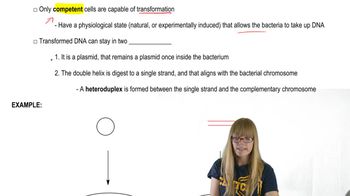What is the endosymbiotic theory, and why is this theory relevant to the study of extranuclear DNA in eukaryotic organelles?
Table of contents
- 1. Introduction to Genetics51m
- 2. Mendel's Laws of Inheritance3h 37m
- 3. Extensions to Mendelian Inheritance2h 41m
- 4. Genetic Mapping and Linkage2h 28m
- 5. Genetics of Bacteria and Viruses1h 21m
- 6. Chromosomal Variation1h 48m
- 7. DNA and Chromosome Structure56m
- 8. DNA Replication1h 10m
- 9. Mitosis and Meiosis1h 34m
- 10. Transcription1h 0m
- 11. Translation58m
- 12. Gene Regulation in Prokaryotes1h 19m
- 13. Gene Regulation in Eukaryotes44m
- 14. Genetic Control of Development44m
- 15. Genomes and Genomics1h 50m
- 16. Transposable Elements47m
- 17. Mutation, Repair, and Recombination1h 6m
- 18. Molecular Genetic Tools19m
- 19. Cancer Genetics29m
- 20. Quantitative Genetics1h 26m
- 21. Population Genetics50m
- 22. Evolutionary Genetics29m
3. Extensions to Mendelian Inheritance
Organelle DNA
Problem 18a
Textbook Question
Mutations in mitochondrial DNA appear to be responsible for a number of neurological disorders, including myoclonic epilepsy and ragged-red fiber disease, Leber's hereditary optic neuropathy, and Kearns-Sayre syndrome. In each case, the disease phenotype is expressed when the ratio of mutant to wild-type mitochondria exceeds a threshold peculiar to each disease, but usually in the 60 to 95 percent range.
Given that these are debilitating conditions, why has no cure been developed? Can you suggest a general approach that might be used to treat, or perhaps even cure, these disorders?
 Verified step by step guidance
Verified step by step guidance1
Understand the problem: Mitochondrial DNA mutations are responsible for several neurological disorders. These disorders manifest when the ratio of mutant to wild-type mitochondria exceeds a specific threshold. The challenge lies in developing a cure due to the unique nature of mitochondrial inheritance and the difficulty in targeting mitochondria therapeutically.
Step 1: Explain why a cure is challenging. Mitochondrial DNA is inherited maternally, and each cell contains multiple mitochondria (heteroplasmy). The ratio of mutant to wild-type mitochondria can vary between cells and tissues, making it difficult to uniformly target and correct the mutation across the body.
Step 2: Discuss the limitations of current treatments. Current therapies focus on managing symptoms rather than addressing the underlying genetic cause. This is because directly editing or replacing mitochondrial DNA is technically challenging due to the double membrane of mitochondria and the lack of efficient delivery systems for therapeutic agents.
Step 3: Suggest a general approach for treatment. One potential strategy is mitochondrial replacement therapy (MRT), where defective mitochondria are replaced with healthy ones. This could be achieved during in vitro fertilization by transferring the nuclear DNA from an affected egg into a donor egg with healthy mitochondria.
Step 4: Explore gene-editing technologies. Another approach could involve using advanced gene-editing tools, such as CRISPR-Cas9 or mitochondrial-specific nucleases, to selectively target and repair mutant mitochondrial DNA. However, this requires further research to ensure precision and safety in targeting mitochondrial genomes.
 Verified video answer for a similar problem:
Verified video answer for a similar problem:This video solution was recommended by our tutors as helpful for the problem above
Video duration:
1mPlay a video:
Was this helpful?
Key Concepts
Here are the essential concepts you must grasp in order to answer the question correctly.
Mitochondrial DNA and Mutations
Mitochondrial DNA (mtDNA) is distinct from nuclear DNA and is inherited maternally. Mutations in mtDNA can disrupt the normal function of mitochondria, which are crucial for energy production in cells. These mutations can lead to various diseases, particularly affecting tissues with high energy demands, such as the nervous system. Understanding the types and effects of these mutations is essential for addressing mitochondrial disorders.
Recommended video:
Guided course

Organelle DNA Characteristics
Threshold Effect in Mitochondrial Disorders
The threshold effect refers to the phenomenon where a certain proportion of mutant mitochondria must be present for a disease phenotype to manifest. In mitochondrial disorders, this threshold typically ranges from 60% to 95% mutant mitochondria. This concept is critical for understanding why individuals may exhibit symptoms at different stages of life and why some may remain asymptomatic despite carrying mutations.
Recommended video:
Guided course

Maternal Effect
Current Treatment Approaches and Challenges
Current treatments for mitochondrial disorders primarily focus on managing symptoms rather than curing the underlying genetic issues. Challenges in developing cures include the complexity of mitochondrial genetics, the difficulty in targeting and repairing mtDNA, and the need for therapies that can effectively reach affected tissues. Research into gene therapy, mitochondrial replacement techniques, and pharmacological interventions represents potential avenues for future treatments.
Recommended video:
Guided course

Transformation

 4:11m
4:11mWatch next
Master Organelle DNA Characteristics with a bite sized video explanation from Kylia
Start learningRelated Videos
Related Practice
Textbook Question
659
views
